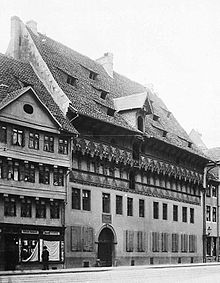Dannenbaum's house
The Dannenbaumsche House ( insurance number 2572) was a patrician house , in the August 33 street in the precincts Altewiek the city of Braunschweig . At least the truss was built in 1517. Like almost the entire development on Auguststrasse, the house was destroyed during the devastating bomb attack on October 15, 1944 and was never rebuilt.
history
The building had a width of 20 spans and four floors, whereby the lower two floors were designed as a solid Gothic building, on which two half-timbered floors were later placed. It is believed that the masonry basement floors may have been built in the 13th or 14th century. The back of the building, however, was entirely half-timbered. The gable walls were also solidly bricked up to the ridge. Wood sculptor Simon Stappen created various carvings, including the foliage stick above the solid building. The year 1517 and the inscription "Och we kans geramen" were written on the stick. Above the gate there were four cleats with figurative representations of St. Andrew, St. Magnus, the holy author , Braunschweig's city saint, and St. Anna herself . In the hall on the first floor there was a head- high beam scale that had been in use for generations. A cannonball was embedded in one of the two firewalls , which is said to have been fired during the siege of the city by Duke Friedrich Ulrich's troops of Braunschweig-Wolfenbüttel in 1615 . The building was renovated around 1880. Finally, the sugar and was in the house grocery store Gebr. Dannebaum.
During the Second World War, an air raid shelter with space for 200 people was set up in Dannenbaum's house . A leaf stick recovered from the rubble of the house is now integrated in the house "Behind the Magni Church 2".
literature
- Hartwig Beseler, Niels Gutschow: War fates of German architecture - losses, damage, reconstruction. Volume 2: Süd, Wiesbaden 2000, ISBN 3-926642-22-X .
- H. Edel: The half-timbered houses of the city of Braunschweig. A picture of art and cultural history. Appelhans Verlag, Braunschweig 1928.
- Paul Jonas Meier and Karl Steinacker : The architectural and art monuments of the city of Braunschweig. 2nd ext. Edition, Braunschweig 1926.
- Norman-Mathias Pingel: Auguststrasse. in: Braunschweiger Stadtlexikon. Published on behalf of the city of Braunschweig by Luitgard Camerer, Manfred RW Garzmann and Wolf-Dieter Schuegraf with special assistance from Norman-Mathias Pingel, Braunschweig 1992, p. 24, ISBN 3-926701-14-5 .
- Constantin Uhde (ed.): The constructions and the art forms of architecture. Volume II: The timber construction. Berlin 1903.
Individual evidence
- ↑ Paul Jonas Meier, Karl Steinacker: The architectural and art monuments of the city of Braunschweig. P. 71.
- ↑ a b c d Paul Jonas Meier, Karl Steinacker: The architectural and art monuments of the city of Braunschweig. P. 86.
- ↑ Dieter Heitefuß: Risen from rubble. Braunschweig and its reconstruction after 1945. A picture documentation. Braunschweig 2005, ISBN 3-9803243-5-4 , p. 119.
- ↑ Ralf Busch : Braunschweig in old views. Volume 1, 15th edition, European Library, Zaltbommel 1995, p. 111.
- ↑ Dieter Heitefuß: Memories of Old Braunschweig 1930-1960. Braunschweig 1995, ISBN 3-9803243-3-8 , p. 82.
- ^ H. Edel: The half-timbered houses of the city of Braunschweig. A picture of art and cultural history. P. 15.
- ^ Norman-Mathias Pingel: Auguststrasse. in: Braunschweiger Stadtlexikon. P. 24.
- ↑ Bunker in Braunschweig
- ^ Robert Slawski: Braunschweiger Fachwerk. Look to the 16th century. A city tour. Braunschweig 1988, ISBN 3-920740-05-X , p. 24.
Remarks
- ↑ “'Frame' is an expression from the carpenter's language , still in use today and means to build up, to erect.” From: H. Edel: Die Fachwerkhäuser der Stadt Braunschweig. A picture of the history of art and culture , Appelhans Verlag, Braunschweig 1928, p. 14
- ↑ According to Andrea Boockmann, the saying means: “Who can achieve it.”, See: The inscriptions of the city of Braunschweig until 1528. Volume 35 of the series Die Deutsche Insschriften. Collected and processed by Andrea Boockmann on the basis of a collection of materials from 1945 to 1986 by the senior director of studies, Dr. Dietrich Mack (†), Braunschweig. Dr. Ludwig Reichert Verlag, Wiesbaden 1993, ISBN 978-3-88226-513-2 , p. XLIX.
Web links
Coordinates: 52 ° 15 ′ 35.5 ″ N , 10 ° 31 ′ 33.5 ″ E


